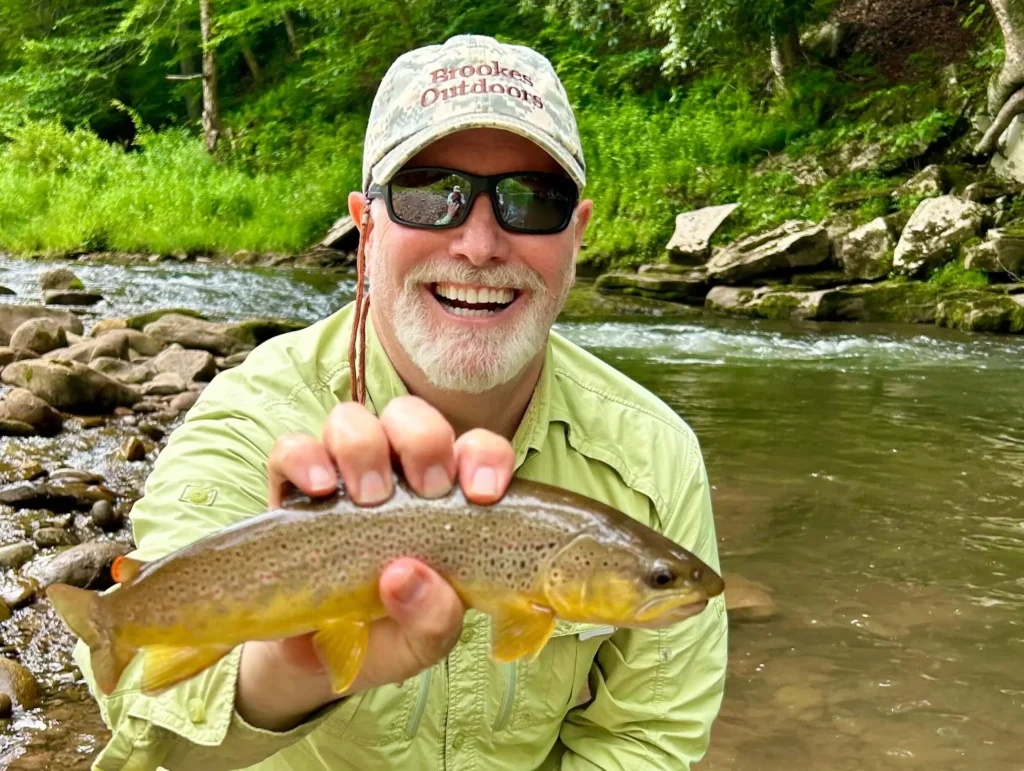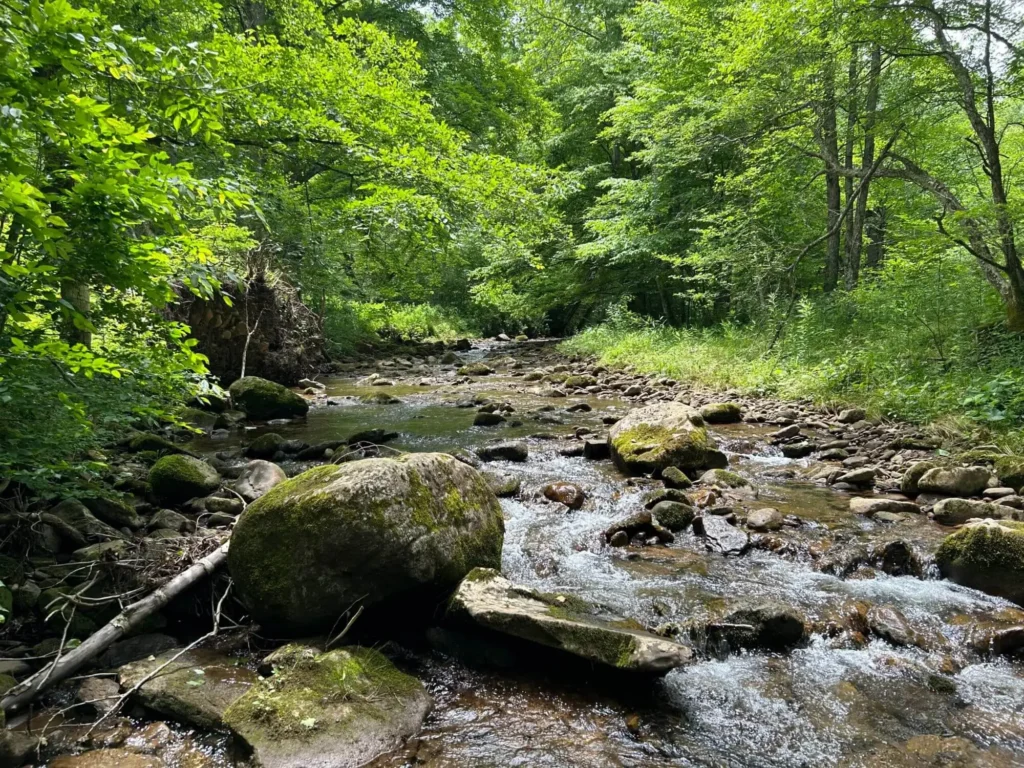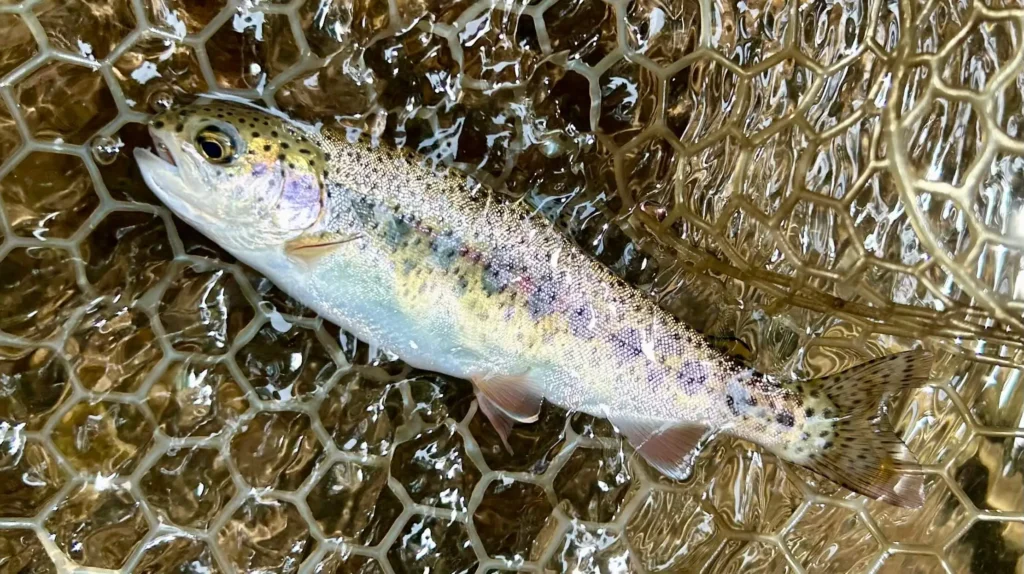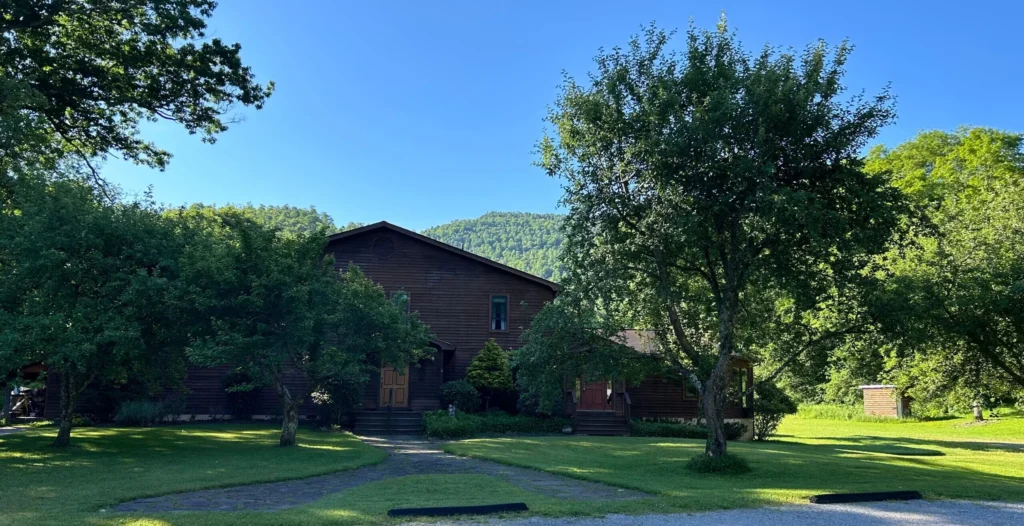West Virginia’s Elk River: Wild (Trout) Wonderful

Don’t get me wrong, I love me some stout-shouldered stockers on the fly from time to time. It’s still fly fishing after all, and stocked trout can be challenging, even frustrating, if they’ve seen their share of flies. But, if given the chance, I’ll take chasing even a smallish wild trout on a natural, crazy-currented, downfall-filled, slippery freestone river with its share of fly-stealing overhanging vegetation any day.
For me, the satisfaction of netting a frisky, naturally-reproducing fish makes all the extra challenge and effort worth it. That’s why I rang up my friend, Gil Willis, at Elk River Inn, Cabins, and Guide Service in Slaty Fork, West (By God) Virginia; I needed a fly fishing fix on the cool, clear waters of the Mountain State pretty bad.
Gil told me that the fishing conditions were good on the Elk River and that early June was ideal. He hooked me up (pun intended) with Caleb Hamner, one of his top guides, for two days of fishing in Pocahontas County, known across the state as the “Birthplace of Rivers.”
Caleb is a perfect ghillie. He’s a trained West Virginia University fishery biologist, and his day job is with the West Virginia Division of Natural Resources, working a wildlife management area in the Elk River’s part of the Monongahela National Forest.
Score!
In fact, Caleb is one of those “fishy” anglers. He’s the type of fisher who is working the same run on the same side of the water at the same time with the same rod, leader, and fly just a few steps away from you – and keeps hooking fish after fish while you struggle to get the skunk off.
You get the picture…
Exploring the Elk River

For the first day of the trip, Gil and Caleb recommended a noonish start on the Slaty Fork section of the (upper) Elk River for wild brook and rainbow trout. (The nearby Cranberry and Greenbrier Rivers weren’t running as well.) I met Caleb at Gil’s place and, in literally minutes, we were on the water. I brought an older Orvis 1-weight for dry flies, and Caleb brought a 10-foot 3-wt. for a dry-dropper rig for dragging deeper holes and plunge pools.
We quickly got into native brookies, netting a couple of decent-sized fish. But the real fun was wrestling wild rainbows on the 1-weight. While smallish on the rainbow trout spectrum, battling 8-inch bucking ‘bows with a 1-weight and 5x tippet was a blast.

After catching 15+ wild brookies and ‘bows in a few hours on this small “nursery” stream, we took a quick break and swapped out gear for the evening. The main quarry tonight would be wild brown trout, hopefully on a bushy dry fly.
With some trepidation about jinxing it, I mentioned to Caleb that a West Virginia wild trout trifecta (i.e., brook, rainbow, and brown trout) was in our sights—if we could bag a wild brownie in the next few hours.
No pressure, no pressure at all…deep breaths, deep breaths.
Not trying to start a donnybrook here, but it’s worth mentioning that local angling legend says that – with its limestone foundation – the Elk River has the most prolific Sulphur hatch of any river on the East Coast outside of the East Branch of the Delaware River in New York’s Catskill Region.
That’s quite a boast.
I’ve obviously not fished every East Coast river, so I can’t say with certainty whether this is true, but I did see a lot of Sulphurs coming off — not to mention I’m pretty sure I swallowed more than my fair share of bugs on the river that evening.
Indeed, I kept thinking that I should’ve brought a neck gaiter along to reduce my incidental intake of insects. Of course, for a fly angler, having a lot of bugs hatching is generally a good problem to have, right?!
Caleb warned me (again) that fly presentation would be critical, especially in “brown town.” The Elk can be very technical like a lot of East Coast waters and, as usual, the bigger browns can be very elusive. In other words, I was going to have to earn any West Virginia wild trout slam that might come my way; the easy part was over that afternoon. As Caleb remarked more than once, “The Lady [as the Elk is sometimes known locally] can be a very cruel mistress.”

Elk Creek Trifecta
The bugs weren’t coming off hard yet, so we rigged up my Moonshine 4-weight with a dry-dropper rig on 5x and started dredging some of the deeper runs. It wasn’t too long before my dry stopped dead in the current and–bloop!–disappeared below the surface.
I set the hook downstream and after a lengthy, nerve-wracking fight, I was rewarded with a 14-inch wild brown; I’d tagged my first West Virginia wild trout trifecta. For me, it was Miller Time, but not for Caleb. We still had a hatch to match and fish to catch.
Caleb advised me that there were 20+ inch browns yet to net.
We bagged another 14-inch brownie and a decent-sized rainbow. With the light fading quickly and bugs all around, we ran a mayfly pattern through a long pool under a big tree which covered the run, making it even darker than the surrounding area.
It was one of those “If you see a rise or hear a splash, set the hook” kind of things; I missed several hookups, but finally bagged a 10-inch brown, providing an excellent ending to a great day of fishing.
Donning headlamps in the West Virginia darkness (no light pollution here…talk about stargazing!), we busted brush on our way up the steep bank to the old, abandoned rail line and headed back to the parking area.
Thankfully, the Elk River Inn was just moments away as I was more than ready to savor my minor mountain angling miracle and hit the rack. We’d easily logged a good number of miles that day; I was beat.
While I was content to sit in the Inn and drink Gil’s coffee the next morning, we decided that we’d hit the lower Elk in hopes of bringing a stocked, bright-yellow Palomino trout to hand; the “banana trout” as some have dubbed them.
The Palomino are a unique species, and were first bred in West Virginia. These fish can disappear early in the spring-summer season — harvested by both anglers and predators. As you can imagine, they’re not very well camouflaged.
Unfortunately, after a leisurely start due to some heavy downpours, we didn’t see any Palominos that day. I did break off some very big (20+ inch) stocked (and likely highly-pressured fish) on my Orvis H3 5-weight and 5x leader. We tried drys, dry-droppers, and streamers, but they’d probably seen it all.
Talk about technical fishing! In my opinion, these fish could tell you not only the fly pattern, but also who’d tied that fly! You can catch wild fish, too, in the lower Elk, but they were all pretty closed-mouthed after the morning front moved through, with the exception of a willing rainbow.
No matter, it’d been a great trip.
Gil and Caleb advised me that with a local base elevation of about 2,500 feet (Snowshoe Ski Resort is nearby), and with some decent rain, fishing on the Elk can be great through the summer. It must be awesome in the fall with the changing leaves — and the trout putting the feed bag on.
Many anglers consider the Elk to be West Virginia’s best trout water. With year-round hatches—from midges to mayflies to caddis — and with the possibility of bringing browns, brookies, ‘bows, and Palomino trout to the net, the Elk River (with props to the late, great John Denver) is an Almost Heaven fishery.
_______________
Dr. Peter Brookes is an award-winning, Virginia-based outdoor scribbler. He can be reached at brookesoutdoors@aol.com.
Did You Enjoy This Article?
Stay up to date with the Dark Skies Fly Fishing monthly newsletter for free and receive the latest posts in fly fishing news, tricks, tips, and techniques, stream reports, as well as updates on new flies added to the Online Store and exclusive discounts!
Sign Up Now


This is a fine piece and I agree the Elk is one of WV’s finest trout streams. Elk River Touring Center is a great place to stay and I can attest that Gil Willis and his staff are top shelf. Do yourself a favor and fish the Elk if you ever get a chance.
How do these rivers keep from being fished out? Is it all catch and release?